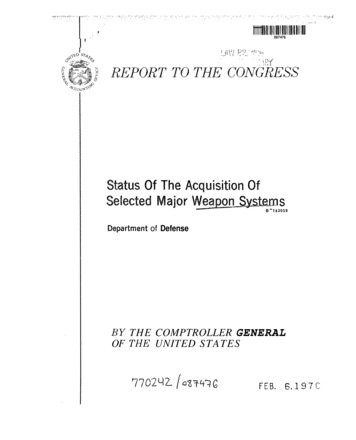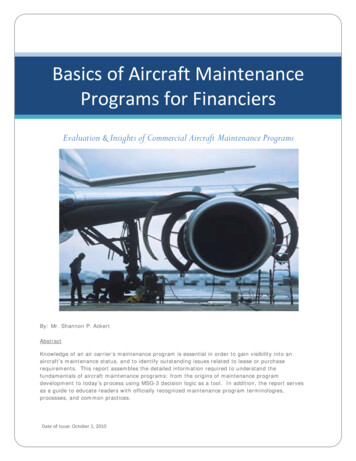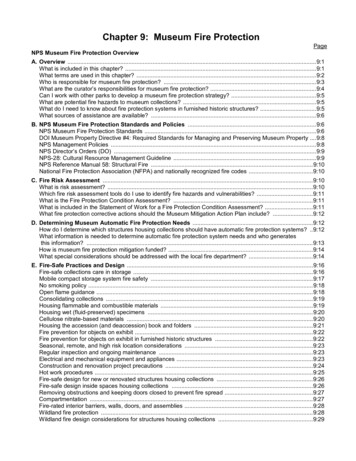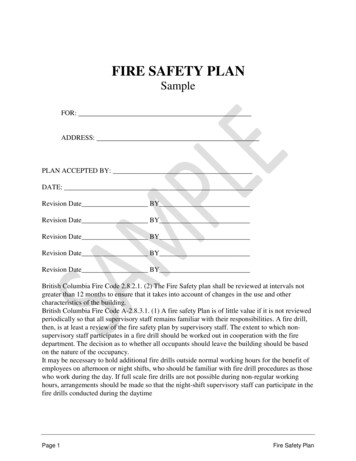
Transcription
Aircraf t HangarFire Prot ect ion
Int roduct ionAgenda›››››Who am I and why am I talking?Challenges of Aircraft HangarsTypes of HangarsFire Protection StrategiesOpen discussion and questions
Int roduct ionW ho Am I?››››››››Fire Protection Engineer – C&S CompaniesAdjunct Professor – Fire Protection TechnologyFirefighter/ EMT – 19 years in fire servicePast President – SFPE NY Empire ChapterCertified Fire Protection Specialist – NFPAOSHA Authorized Outreach TrainerM.S. – Safety, Security & Emergency ManagementB.S. – Fire & Safety Engineering Technology
Overview ofAircraf t Hangars
Aircraf t HangarsOverview
Aircraf t HangarsOverview
Aircraf t HangarsOverview
Cl assif icat ion ofAircraf t Hangars
Aircraf t HangarsCl assif icat ion› NFPA 409 Standard on Aircraft Hangars› Group I› Group II› Group III› Group IV› UFC 4-211-01 Aircraft Maintenance Hangars› Air Force› Army› Navy/ Marine
Aircraf t HangarsNFPA 409 Group I› Aircraft access door height over 28’› Single fire area in excess of 40,000 ft 2› Aircraft with tail height over 28’
Aircraf t HangarsNFPA 409 Group II› Aircraft access door height of 28’ or less› Single fire area not larger than 40,000 ft 2
Aircraf t HangarsNFPA 409 Group III› Aircraft access door height of 28’ or less
Aircraf t HangarsNFPA 409 Group IV› Membrane-covered rigid, steel frame structure
Aircraf t HangarsUFC 4-211-01› All military hangars are classified as NFPA 409 Group I› Specific design requirements for individual branches
Aircraf t HangarsUFC 4-211-01› Air Force› ET02-15 – Fire Protection Engineering Criteria for AircraftMaintenance, Servicing and Storage Facilities.› Army› Army Standard for the Aircraft Maintenance Hangar(HGR) Complex› Navy/ Marines› ITG 2003-01 – Aircraft Maintenance Facility Design› F35 or C Supplement
Fire Prot ect ion St rat egiesOverview› Provide a reasonable degree of protection from fire forlife and property based on sound engineeringprinciples, test data, and field experience.› Protect Life› Protect Aircraft› Protect Building
Fire Prot ect ion St rat egiesDecision TreeCLASSIFY HANGARDETERMINEMONITOR LOCATIONANDAREA OF COVERAGEDETERMINEMONITOR SYSTEMDISCHARGE TIME &APPLICATION RATECALCULATEMONITOR SYSTEMFOAM QUANTITYREVIEWPROTECTION OPTIONSDETERMINE PRIMARY SYSTEMTYPE, DISCHARGE TIMEAND APPLICATION RATECALCULATE PRIMARYFOAM QUANTITYCALCULATE TOTALFOAM QUANTITYCOMPLETEBILL OF MATERIALSDETERMINEHAND HOSE LINEREQUIREMENTS
Fire Prot ect ion St rat egiesNFPA 409› Primary Foam-Water Sprinkler Systems› May require supplemental oscillating monitors› Foam monitor systems› High Expansion Foam System› Supplemental Requirements for all above:› Foam-Water Hand Hose Line Systems
Fire Prot ect ion St rat egiesUnif ied Facil it ies Crit eria› All military hangars are classified as a Group I application in referenceto NFPA 409 however they follow a specific design application.› Airf orce/ Airguard – High Expansion systems with foam inductorproportioning and an atmospheric poly tank for foam storage.› Arm y – High expansion system with main and reserve foam pumpproportioning and atmospheric poly tank for foam storage.› Navy/ Marine (NAVFAC) – AFFF foam systems with foam inductorproportioning, trench nozzle discharge device and atmospheric polytank for foam storage.› All hangars require a dead man switch to stop foam
Case St udies
Case St udy # 1Group II Hangars› Private Aviation Facility› Design & Construction of new hangar› Design/ Building contract› FP Contractor brought in late – no FPE involved› Big ticket item missed early (No Foam!)› Owner consulted with multiple FPEs› All had similar conversations (consistency is good)› Business plan changed (no maintenance)
Case St udy # 2Tw o Group II Hangars› Private Aviation Facilities› Expansion of existing (operational) hangar ( 6,000 SQ FT)› Insufficient fire suppression system› Adjacent (operational) hangar with similar issues› Water supply concerns (pressure and volume)› Owner challenges› Scope change – owner education› Convert to wet-pipe/ hi-ex foam (both hangars)› Update fire alarm/ detection› 3 Fire pumps & new building
Case St udy # 3Tw o Group II Hangars› Stewart IAP› Competing stakeholder interest››››Army hangarsAir base,NYS PoliceNY/ NJ Port Authority› Convert existing water deluge to wet-pipe & high expansion foam› Design-Build contract/ Restricted budget› Known water supply deficiencies› New Contractors
Case St udy # 4Tw o Group I Hangars› Plattsburgh IAP› Two 26,000 SQ FT nose docks› Complete renovation (we’ve done this before)› Modification to operational hangar› Wet-pipe sprinklers, hi-ex foam, hose reels, alarm, and detection› Tight construction schedules & budgets› Scope change via addendum› Wet-pipe sprinklers, alarm & detection› Extend existing pre-action, alarm & detection
Case St udy # 5Group I Hangar› Confidential Aviation Hangar› New hangar design› Three bays – one fire area› Wet-pipe sprinkler, hi-ex foam, hose reels, pumps, alarm & detection› AHJ initiated design change late› AFFF deluge sprinklers› 6 zones› 5 operate with design fire› Water supply impact (7,800 / - gpm)› Contractor relationships
Case St udy # 6Group I Hangar› Melbourne MRO› Design & Construction new hangar› Design/ build contract› Experienced construction & design team (new partnership)› 30% design for proposal› Multiple approaches› Issues with bidding process (TBD)
Cl osingPresentation Take Away:1.Determine Water Supply Early2.Communicate Expectations to Stakeholder3.Performance vs Prescriptive Questions Open Discussion Kevin Geidel, EIT, CFPSkgeidel@cscos.com315.455.2000
› Wet-pipe sprinkler, hi -ex foam, hose reels, pumps, alarm & detection › AHJ initiated design change late › AFFF deluge sprinklers › 6 zones › 5 operate with design fire › Water supply impact (7,800 / - gpm) › Contractor relationships. Case Study # 6. Group I Hangar










